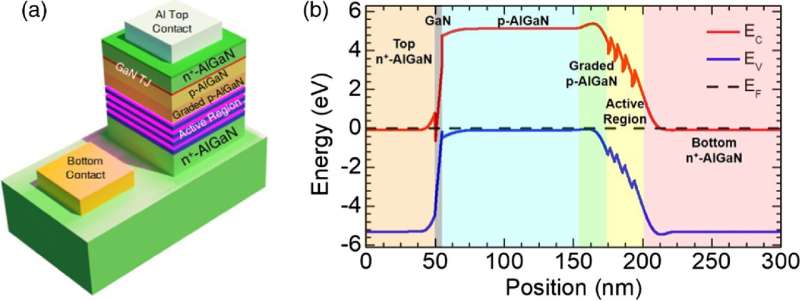High-efficiency ultraviolet light emitting diodes to sterilize pathogens, including COVID-19

ECE Ph.D. student Ayush Pandey details the research led by Prof. Zetian Mi on using high efficiency ultraviolet light emitting diodes to sterilize pathogens. This research, "High-efficiency AlGaN/GaN/AlGaN tunnel junction ultraviolet light-emitting diodes," won the 2020 Editor-in-Chief Choice Award from Photonics Research.
Every year, thousands of lives and billions of dollars are spent worldwide as a result of health-care associated and waterborne illnesses. Sterilization is a critical preventative measure and it can be achieved by a number of techniques including irradiation using ultraviolet (UV) light. This need has gained greater urgency because of the global coronavirus pandemic, as effective sterilization practices can curtail the spread of infectious diseases.
Current sources like mercury lamps are bulky, contain toxic chemicals and are not as versatile in applications as semiconductor light sources. AlGaN is the material of choice for high efficiency deep UV light sources, which is the only alternative technology to replace mercury lamps for water purification and disinfection. To date, however, AlGaN-based mid and deep UV LEDs exhibit very low efficiency. One of the primary limiting factors is the poor hole injection, due to the ineffective p-type doping of AlGaN alloys using Mg, especially for the high Al composition alloys that are essential for the UV-C (200-280 nm) wavelength ranges.
A promising technique that can overcome this challenge and enhance hole injection into the device active region is by utilizing a tunnel junction structure. The hole injection in such devices is driven by the interband transport of electrons from the valence band of the p-type layer to the conduction band of the n-type layer.
Prof. Zetian Mi's group at the University of Michigan has performed a detailed investigation of the design, epitaxy, fabrication, and characterization of tunnel junction UV-C LEDs operating at ~265 nm. The large bandgaps and reduced doping efficiency of AlGaN make it difficult to obtain direct tunneling between the p-type and n-type layers. To overcome this issue, the team has studied unique device designs including a thin GaN tunnel junction layer with different thicknesses, as well as different thicknesses of the top n-type AlGaN.
This technique relies on the large spontaneous and piezoelectric polarization fields of the III-nitrides, which can be manipulated by sandwiching a layer of different material composition in between the doped layers, dramatically increasing the tunneling probability. Moreover, a special metal-semiconductor junction assisted epitaxy method was developed to dramatically improve the Mg doping and hole concentration of Al-rich AlGaN layers.
The optimized tunnel junction device showed much improved current-voltage characteristics as compared to a conventional LED with a p-type AlGaN contact layer. The improved injection in the tunnel junction device translated into stronger electroluminescence, without the presence of any defect emission peaks. The emission was also observed to be extremely stable with little variation in peak position over a broad injection current range. The team has achieved a maximum external quantum efficiency of ~11% and wall-plug efficiency of ~7.6%, which are the highest values ever reported for a deep UV LED operating at ~265 nm to our knowledge, providing a viable path to break the efficiency bottleneck of deep UV photonics.
More information: A. Pandey et al, High-efficiency AlGaN/GaN/AlGaN tunnel junction ultraviolet light-emitting diodes, Photonics Research (2020). DOI: 10.1364/PRJ.383652
Provided by University of Michigan




















